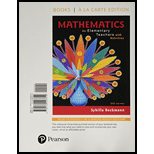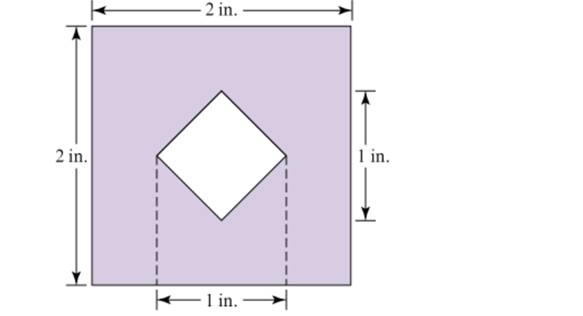
Use the moving and additivity principles to determine the area, in square inches, of the shaded region in Figure 12.17 . The shape is a 2-inch-by-2-inch square. with a square, placed diagonally inside, removed from the middle. In determining the area of the shape, use no formulas other than the one for areas of rectangles. Explain your reasoning clearly.

Figure 12.17 A shape with a hole.
Want to see the full answer?
Check out a sample textbook solution
Chapter 12 Solutions
Mathematics for Elementary Teachers with Activities, Books a la carte edition (5th Edition)
Additional Math Textbook Solutions
College Algebra Essentials (5th Edition)
Pathways To Math Literacy (looseleaf)
College Algebra (Collegiate Math)
Finite Mathematics for Business, Economics, Life Sciences and Social Sciences
Elementary Statistics Using The Ti-83/84 Plus Calculator, Books A La Carte Edition (5th Edition)
- Let {Yt} be an AR(2) process of the special form Yt = φ2Yt − 2 + et. Use first principles to find the range of values of φ2 for which the process is stationary.arrow_forwardDescribe the important characteristics of the autocorrelation function for the following models: (a) MA(1), (b) MA(2), (c) AR(1), (d) AR(2), and (e) ARMA(1,1).arrow_forwarda) prove that if (x) is increasing then (x~) is bounded below and prove if (is decrasing then (xn) is bounded above- 6) If Xn is bounded and monotone then (Xa) is Convergent. In particular. i) if (xn) is bounded above and incrasing then lim xn = sups xn: ne№3 n700 ii) if (X) is bounded below and decrasing then I'm Xn = inf\x₂,neN} 4500 143arrow_forward
- 5. Consider the following vectors 0.1 3.2 -0-0-0 = 5.4 6.0 = z= 3 0.1 For each of exercises a-e, either compute the desired quantity by hand with work shown or explain why the desired quantity is not defined. (a) 10x (b) 10-27 (c) J+Z (d) (x, y) (e) (x, z)arrow_forward1) let X: N R be a sequence and let Y: N+R be the squence obtained from x by di scarding the first meN terms of x in other words Y(n) = x(m+h) then X converges to L If and only is y converges to L- 11) let Xn = cos(n) where nyo prove D2-1 that lim xn = 0 by def. h→00 ii) prove that for any irrational numbers ther exsist asquence of rational numbers (xn) converg to S.arrow_forwardConsider the graph/network plotted below. 1 6 5 3 Explicitly give (i.e., write down all of the entries) the adjacency matrix A of the graph.arrow_forward
- . Given the function f: XY (with X and Y as above) defined as f(2) = 2, f(4) = 1, ƒ(6)=3, ƒ(8) = 2, answer the following questions. Justify your answers. (a) [4 points] Is f injective? (b) [4 points] Is f surjective? (c) [2 points] Is f bijective?arrow_forward1. Let 15 -14 A = -10 9 13-12 -8 7 11 15 -14 13 -12 -6 and B = -10 9 -8 7 -6 5 -4 3 -2 E 5 -4 3 -2 1 Explicitly give the values of A2,3, A1,5, and B1,4- Is A a 5 x 3 matrix? Explain your answer. Are A and B (mathematically) equal? Explain your answer.arrow_forwardGiven the following set X = {2, 4, 6, 8} and Y = {1, 2, 3}, explicitly give (e.g., write down the sets with numerical entries) of the outputs of the following requested set operations: (a) [2 points] XUY (Union) (b) [2 points] XY (Intersection) (c) [3 points] X\Y (Difference) (d) [3 points] XAY (Symmetric Difference)arrow_forward
- 4.2 Product and Quotient Rules 1. 9(x)=125+1 y14+2 Use the product and/or quotient rule to find the derivative of each function. a. g(x)= b. y (2x-3)(x-1) c. y== 3x-4 √xarrow_forward4.2 Product and Quotient Rules 1. Use the product and/or quotient rule to find the derivative of each function. 2.5 a. g(x)=+1 y14+2 √x-1) b. y=(2x-3)(x-:arrow_forwardFor what values of k will the equation (k + 1)x² + 6kx + 2k² - x = 0 have: a) one root equal zero b) one root the reciprocal of the other c) roots numerically equal but of opposite signarrow_forward

 Glencoe Algebra 1, Student Edition, 9780079039897...AlgebraISBN:9780079039897Author:CarterPublisher:McGraw Hill
Glencoe Algebra 1, Student Edition, 9780079039897...AlgebraISBN:9780079039897Author:CarterPublisher:McGraw Hill Holt Mcdougal Larson Pre-algebra: Student Edition...AlgebraISBN:9780547587776Author:HOLT MCDOUGALPublisher:HOLT MCDOUGAL
Holt Mcdougal Larson Pre-algebra: Student Edition...AlgebraISBN:9780547587776Author:HOLT MCDOUGALPublisher:HOLT MCDOUGAL Trigonometry (MindTap Course List)TrigonometryISBN:9781337278461Author:Ron LarsonPublisher:Cengage LearningAlgebra & Trigonometry with Analytic GeometryAlgebraISBN:9781133382119Author:SwokowskiPublisher:Cengage
Trigonometry (MindTap Course List)TrigonometryISBN:9781337278461Author:Ron LarsonPublisher:Cengage LearningAlgebra & Trigonometry with Analytic GeometryAlgebraISBN:9781133382119Author:SwokowskiPublisher:Cengage Elementary Geometry For College Students, 7eGeometryISBN:9781337614085Author:Alexander, Daniel C.; Koeberlein, Geralyn M.Publisher:Cengage,
Elementary Geometry For College Students, 7eGeometryISBN:9781337614085Author:Alexander, Daniel C.; Koeberlein, Geralyn M.Publisher:Cengage,





